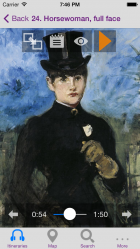
This Flemish painter, who was a contemporary of Rubens and Velázquez, became famous for his magnificent portraits. As a young man, he moved to England, where King Charles I offered him, along with a good financial stipend, a mansion in London and a Villa on the outskirts of the city.
This portrait of Jacques le Roy was painted in Antwerp, shortly before Van Dyck left for England. Le Roy was an influential figure in the Netherlands, with links to the Spanish court. Notice the large ruff around his neck. This type of collar would gradually disappear during the 17th century, to be replaced by lace collars, which were much more comfortable and easier to clean. This is a very realistic portrait, which highlights the majestic appearance of the sitter and the elegance of his hands. The red curtain, and the light that inundates the entire portrait confirm Van Dyck as one of the great portraitists of all time.
Interestingly, the sitter is holding a piece of paper in his left hand that was known in Spain as a “memorial”. It was a kind of petition or request that also appeared in Velazquez’s portraits of Philip IV or the Count-Duke of Olivares, which were painted around the same time.
(c) (R) 2013, MUSMon com S.L.
Text (a) Catalina Serrano Romero
RUBENS - Venus y Cupido
Rubens, es el más famoso pintor flamenco del siglo XVII, representante del estilo barroco y del que la corte española poseía una magnifica colección, hoy día alojada en el Museo del Prado. Esto fue posible gracias a su vinculación política con España, ya que Isabel Clara Eugenia, hija de Felipe II, era la soberana de los Países Bajos.
Dentro de los temas preferidos por Rubens destaca el mitológico como el de esta obra dedicada a Venus y Cupido. En ella podemos apreciar la fuerte influencia de Tiziano en el manejo de la luz, en la composición y en el color. La belleza de la diosa se refleja en el espejo que le ofrece Cupido, su bello hijo, nacido de su unión con Marte. El mismo asunto aparecerá en la Venus del espejo de Velazquez, pero tratado de un modo muy diferente.
La diosa aparece sentada y semicubierta por una túnica blanca que le deja al descubierto un pecho. Está arropada por una capa roja que es la nota de color más importante del cuadro. Su rostro y su cabello evocan la belleza ideal del Renacimiento pese a ser un artista plenamente barroco. Es muy elegante la mano que sujeta la túnica, que nos recuerda a las manos del Greco, pero mucho más sensuales.
(c) (R) 2013, MUSMon com S.L.
Text (a) Catalina Serrano Romero
Picture
Source: Wikimedia Commons
Author: JarektUploadBot
Permission: This artwork is in the public domain: The author of this artwork died more than 70 years ago. According to E.U. Copyright Law, copyright expires 70 years after the author's death. In other countries, legislation may differ.
Independently produced by MUSMon.com, the audio guide for the Thyssen-Bornemisza Museum offers you a wide-ranging, light-hearted and educational tour of one of Spain’s most outstanding art museums. It contains 90 minutes of commentary, illustrated with over 52 high-quality images, so you won’t miss a single detail during your visit.
We will guide you on your journey through the history of painting. +info




































































